Coupling Relationship between Urbanization and Green Total Factor Productivity in the Context of Population Shrinkage: Evidence from the Rust Belt Region of China
Abstract
1. Introduction
2. Materials and Methods
2.1. Study Area and Data Source
2.2. Construction of Index System
2.2.1. Index System of Population Shrinkage
2.2.2. Index System of Urbanization
2.2.3. Index System of GTFP
2.3. Research Methods
2.3.1. Entropy-Weighting Method
2.3.2. SBM-ML Index
2.3.3. CCD Model
2.3.4. Spatial Autocorrelation Analysis
2.3.5. Spatial Econometric Model
3. Results
3.1. Measurement of Urban Population Shrinkage
3.2. Measurement of Urbanization and GTFP
3.3. Analysis of the CCD of Urbanization and GTFP under Different Population Shrinkage Contexts
3.3.1. Temporal Characterization Analysis
3.3.2. Spatial Characterization Analysis
3.4. Analysis of Influencing Factors
3.4.1. Variable Selection and Regression Analysis
3.4.2. Analysis of Influencing Factors
3.4.3. Spatial Spillovers of Influencing Factors
3.4.4. Heterogeneity Analysis of Influencing Factors
4. Discussion
4.1. Population Shrinkage Analysis
4.2. Analysis of the Level of Coordination between Urbanization and GTFP
4.3. Analysis of Influencing Factors
5. Conclusions
Author Contributions
Funding
Institutional Review Board Statement
Informed Consent Statement
Data Availability Statement
Conflicts of Interest
References
- UN. 2018 Revision of World Urbanization Prospects. 2018. Available online: https://www.un.org/zh/desa/2018-revision-world-urbanization-prospects (accessed on 13 April 2023).
- Fan, J.J.; Wang, J.L.; Qiu, J.X.; Li, N. Stage effects of energy consumption and carbon emissions in the process of urbanization: Evidence from 30 provinces in China. Energy 2023, 276, 127655. [Google Scholar] [CrossRef]
- Wang, J.Y.; Wang, S.J.; Li, S.J.; Feng, K.S. Coupling analysis of urbanization and energy environment efficiency: Evidence from Guangdong province. Appl. Energy 2019, 254, 113650. [Google Scholar] [CrossRef]
- Bi, Y.Z.; Zheng, L.; Wang, Y.; Li, J.F.; Yang, H.; Zhang, B.W. Coupling relationship between urbanization and water-related ecosystem services in China’s Yangtze River economic Belt and its socio-ecological driving forces: A county-level perspective. Ecol. Ind. 2023, 146, 109871. [Google Scholar] [CrossRef]
- Shi, X.Y.; Matsui, T.; Machimura, T.; Haga, C.; Hu, A.; Gan, X.Y. Impact of urbanization on the food–water–land–ecosystem nexus: A study of Shenzhen, China. Sci. Total Environ. 2022, 808, 152138. [Google Scholar] [CrossRef]
- Huang, Z.Y.; An, X.Y.; Cai, X.R.; Chen, Y.N.; Liang, Y.Q.; Hu, S.X.; Wang, H. The impact of new urbanization on PM2.5 concentration based on spatial spillover effects: Evidence from 283 cities in China. Sustain. Cities Soc. 2023, 90, 104386. [Google Scholar] [CrossRef]
- Xu, J.J.; Wang, J.C.; Li, R.; Yang, X.J. Spatio-temporal effects of urbanization on CO2 emissions: Evidences from 268 Chinese cities. Energy Policy 2023, 177, 113569. [Google Scholar] [CrossRef]
- Liu, R.R.; Dong, X.B.; Wang, X.C.; Zhang, P.; Liu, M.X.; Zhang, Y. Relationship and driving factors between urbanization and natural ecosystem health in China. Ecol. Ind. 2023, 147, 109972. [Google Scholar] [CrossRef]
- Weiskopf, S.R.; Rubenstein, M.A.; Crozier, L.G.; Gaichas, S.; Griffis, R.; Halofsky, E.J.; Hyde, K.J.W.; Morelli, T.L.; Morisette, J.T.; Muñoz, R.C. Climate change effects on biodiversity, ecosystems, ecosystem services, and natural resource management in the United States. Sci. Total Environ. 2020, 733, 137782. [Google Scholar] [CrossRef] [PubMed]
- Crandall, R.W. The Continuing Decline of Manufacturing in the Rust Belt; Brookings Institution: Washington, DC, USA, 1993. [Google Scholar]
- Hobor, G. Surviving the era of deindustrialization: The new economic geography of the urban rust belt. J. Urban Aff. 2013, 35, 417–434. [Google Scholar] [CrossRef]
- Xie, L.; Yang, Z.S.; Cai, J.M.; Cheng, Z.; Wen, T.; Song, T. Harbin: A rust belt city revival from its strategic position. Cities 2016, 58, 26–38. [Google Scholar] [CrossRef]
- National Bureau of Statistics. 2006–2020. Available online: http://www.stats.gov.cn/ (accessed on 13 April 2023).
- Wu, X.Y.; Zhang, Y.J.; Wang, L.Z. Coupling relationship between regional urban development and eco-environment: Inspiration from the old industrial base in Northeast China. Ecol. Ind. 2022, 142, 109259. [Google Scholar] [CrossRef]
- Caviglia-Harris, J.L.; Chambers, D.; Kahn, J.R. Taking the “U” out of Kuznets: A comprehensive analysis of the EKC and environmental degradation. Ecol. Econ. 2009, 68, 1149–1159. [Google Scholar] [CrossRef]
- Kuznets, S. Economic growth and income equality. Am. Econ. Rev. 1955, 45, 1–28. [Google Scholar]
- OECD. Indicators to Measure Decoupling of Environmental Pressure from Economic Growth; OECD: Paris, France, 2022. [Google Scholar]
- Ma, S.J.; Wang, R.S. The social-economical-natural complex ecosystem. Acta Ecol. Sin. 1984, 4, 1–9. [Google Scholar]
- Fang, C.L.; Zhou, C.H.; Gu, C.L.; Chen, L.D.; Li, S.C. Theoretical analysis of interactive coupled effects between urbanization and eco-environment in mega-urban agglomerations. Acta Geogr. Sin. 2016, 71, 531–550. [Google Scholar] [CrossRef]
- Fang, C.L.; Cui, X.G.; Liang, L.W. Theoretical analysis of urbanization and eco-environment coupling coil and coupler control. Acta Geogr. Sin. 2019, 74, 2529–2546. [Google Scholar]
- Wei, G.E.; Bi, M.; Liu, X.; Zhang, Z.K.; He, B.J. Investigating the impact of multi-dimensional urbanization and FDI on carbon emissions in the belt and road initiative region: Direct and spillover effects. J. Clean. Prod. 2022, 384, 135608. [Google Scholar] [CrossRef]
- Wang, W.Z.; Liu, L.C.; Liao, H.; Wei, Y.M. Impacts of urbanization on carbon emissions: An empirical analysis from OECD countries. Energy Policy 2021, 151, 112171. [Google Scholar] [CrossRef]
- Warsame, A.A.; Abdi, A.H.; Amir, A.Y.; Azman-Saini, W.N.W. Towards sustainable environment in Somalia: The role of conflicts, urbanization, and globalization on environmental degradation and emissions. J. Clean. Prod. 2023, 406, 136856. [Google Scholar] [CrossRef]
- Ahmed, Z.; Zafar, M.W.; Ali, S. Linking urbanization, human capital, and the ecological footprint in G7 countries: An empirical analysis. Sustain. Cities Soc. 2020, 55, 102064. [Google Scholar] [CrossRef]
- Feng, Y.D.; Yuan, H.X.; Liu, Y.B. The energy-saving effect in the new transformation of urbanization. Econ. Anal. Policy 2023, 78, 41–59. [Google Scholar] [CrossRef]
- Yao, Y.R.; Shen, Y.; Liu, K.X. Investigation of resource utilization in urbanization development: An analysis based on the current situation of carbon emissions in China. Resour. Policy 2023, 82, 103442. [Google Scholar] [CrossRef]
- Levin, S.; Xepapadeas, T.; Cr’epin, A.-S.; Norberg, J.; Zeeuw, A.D.; Folke, C.; Hughes, T.; Arrow, K.; Barrett, S.; Daily, G. Social-ecological systems as complex adaptive systems: Modeling and policy implications. Environ. Dev. Econ. 2013, 18, 111–132. [Google Scholar] [CrossRef]
- Gao, D.; Li, Y.; Tan, L.F. Can environmental regulation break the political resource curse: Evidence from heavy polluting private listed companies in China. J. Environ. Plan. Manag. 2023, 1–27. [Google Scholar] [CrossRef]
- Diao, S.; Yuan, J.D. Multidimensional measurements of coordinated development level of Harbin-Changchun urban agglomeration. Econ. Geogr. 2022, 42, 86–94. [Google Scholar]
- Sun, Y.S.; Tong, L.J. Spatio-temporal coupling relationship between development strength and eco-environment in the restricted development zone of Northeast China. Sci. Geogr. Sin. 2021, 41, 684–694. [Google Scholar]
- Zhao, J.J.; Liu, Y.; Zhu, Y.K.; Qin, S.L.; Wang, Y.H.; Miao, C.H. Spatiotemporal differentiation and influencing factors of the coupling and coordinated development of new urbanization and ecological environment in the Yellow River Basin. Resour. Sci. 2020, 42, 159–171. [Google Scholar] [CrossRef]
- Ostrom, E. A general framework for analyzing sustainability of social-ecological systems. Science 2009, 325, 419–422. [Google Scholar] [CrossRef]
- Xu, Z.H.; Peng, J.; Liu, Y.X.; Qiu, S.J.; Zhang, H.B.; Dong, J.Q. Exploring the combined impact of ecosystem services and urbanization on SDGs realization. Appl. Geogr. 2023, 153, 102907. [Google Scholar] [CrossRef]
- Liu, Z.; Qi, W.; Qi, H.G.; Liu, S.H. The evolution of regional population decline and its driving factors at the county level in China from 1990 to 2015. Geogr. Res. 2020, 39, 1565–1579. [Google Scholar]
- Qi, W.; Liu, S.H.; Jin, F.J. Calculation and spatial evolution of population loss in Northeast China. Sci. Geogr. Sin. 2017, 37, 1795–1804. [Google Scholar]
- Li, H.; Liang, X.X. Responses of housing price under different directions of population change: Evidence from China’s Rust Belt. Chin. Geogr. Sci. 2022, 32, 405–417. [Google Scholar] [CrossRef]
- Ning, J. Main Data of the Seventh National Population Census From. 2021. Available online: http://www.stats.gov.cn/english/PressRelease/202105/t20210510_1817185.html (accessed on 13 April 2023).
- Liu, Z.; Qi, H.G.; Qi, W.; Liu, S.H. Temporal- spatial pattern of regional population shrinkage in China in 1990–2010: A multi-indicators measurement. Sci. Geogr. Sin. 2019, 39, 1525–1536. [Google Scholar]
- Fu, J.Y.; Hu, J.; Cao, X. Different sources of FDI, environmental regulation and green total factor productivity. J. Int. Trade 2018, 7, 134–148. [Google Scholar]
- Wang, S.J.; Kong, W.; Ren, L.; Zhi, D.D.; Dai, B.T. Research on misuses and modification of coupling coordination degree model in China. J. Nat. Resour. 2021, 36, 793–810. [Google Scholar] [CrossRef]
- Wolff, M.; Wiechmann, T. Urban growth and decline: Europe’s shrinking cities in a comparative perspective 1990—2010. Eur. Urban Reg. Stud. 2018, 25, 122–193. [Google Scholar] [CrossRef]
- Zhang, K.Y.; Zhang, J. Polycentricity and green development efficiency of urban agglomerations: Spatial distribution of urbanization based on heterogeneity. China Popul. Resour. Environ. 2022, 32, 107–117. [Google Scholar]
- Zhu, W.T.; Lv, C.R.; Gu, N.H. Research on the influence of OFDI and reverse technology spillover on green total factor productivity. China Popul. Resour. Environ. 2019, 29, 63–73. [Google Scholar]
- Gao, D.; Tan, L.; Mo, X.; Xiong, R. Blue Sky Defense for Carbon Emission Trading Policies: A Perspective on the Spatial Spillover Effects of Total Factor Carbon Efficiency. Systems 2023, 11, 382. [Google Scholar] [CrossRef]
- Yang, G.Y.; Zhao, H.M.; Tong, D.Q.; Xiu, A.J.; Zhang, X.L.; Gao, C. Impacts of post-harvest open biomass burning and burning ban policy on severe haze in the Northeastern China. Sci. Total Environ. 2020, 716, 136517. [Google Scholar] [CrossRef]
- Bai, Y.J.; Guo, R. The construction of green infrastructure network in the perspectives of ecosystem services and ecological sensitivity: The case of Harbin, China. Glob. Ecol. Conserv. 2021, 27, e01534. [Google Scholar] [CrossRef]
- Chen, Y.; Zhang, D.N. Evaluation and driving factors of city sustainability in Northeast China: An analysis based on interaction among multiple indicators. Sustain. Cities Soc. 2021, 67, 102721. [Google Scholar] [CrossRef]
- Sun, P.J.; Wang, K.W. Identification and stage division of urban shrinkage in the three provinces of Northeast China. Acta Geogr. Sin. 2021, 76, 1366–1379. [Google Scholar]
- Batty, M. Empty buildings, shrinking cities and ghost towns. Environ. Plan. B Plan. Des. 2016, 43, 3–6. [Google Scholar] [CrossRef]
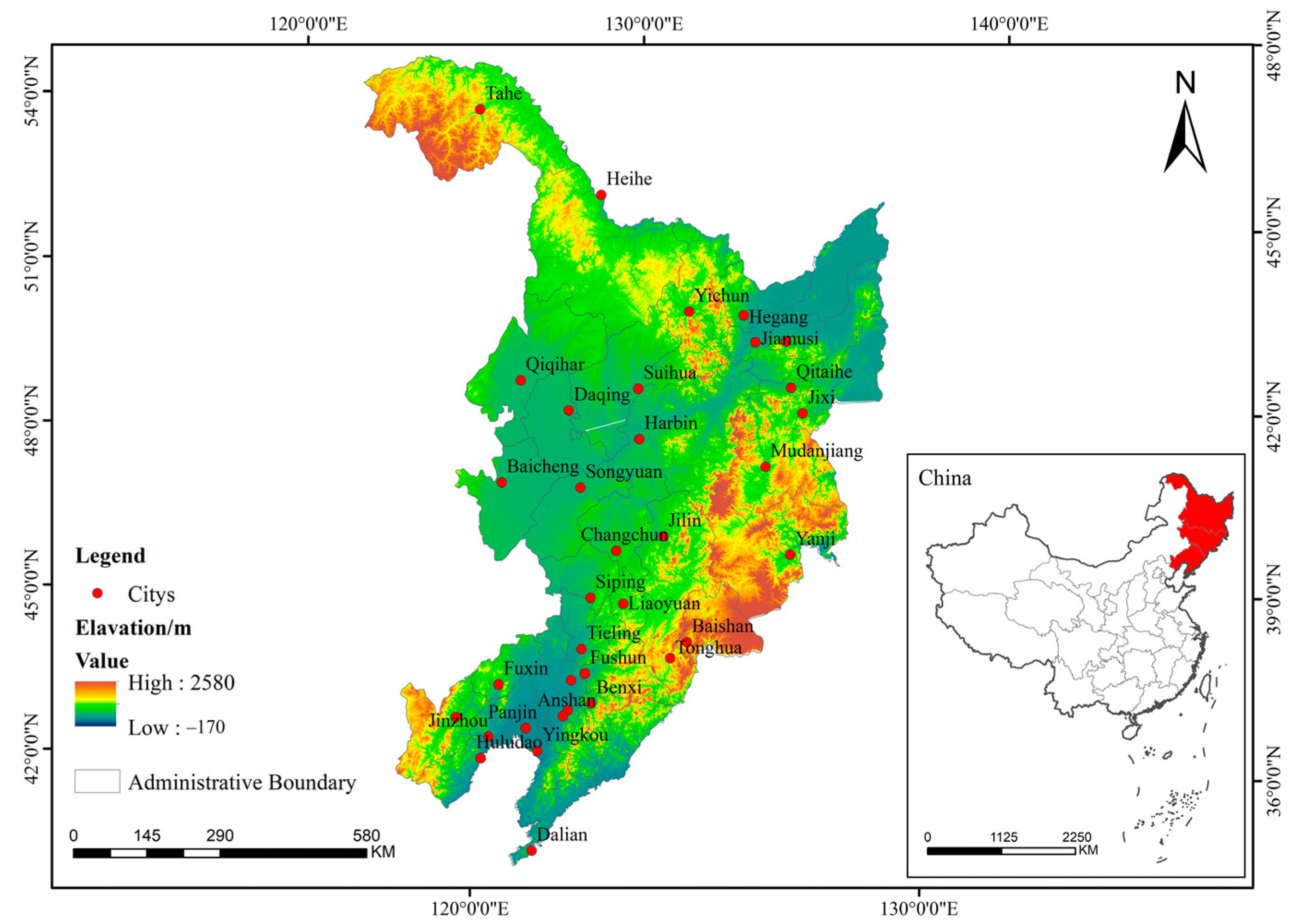
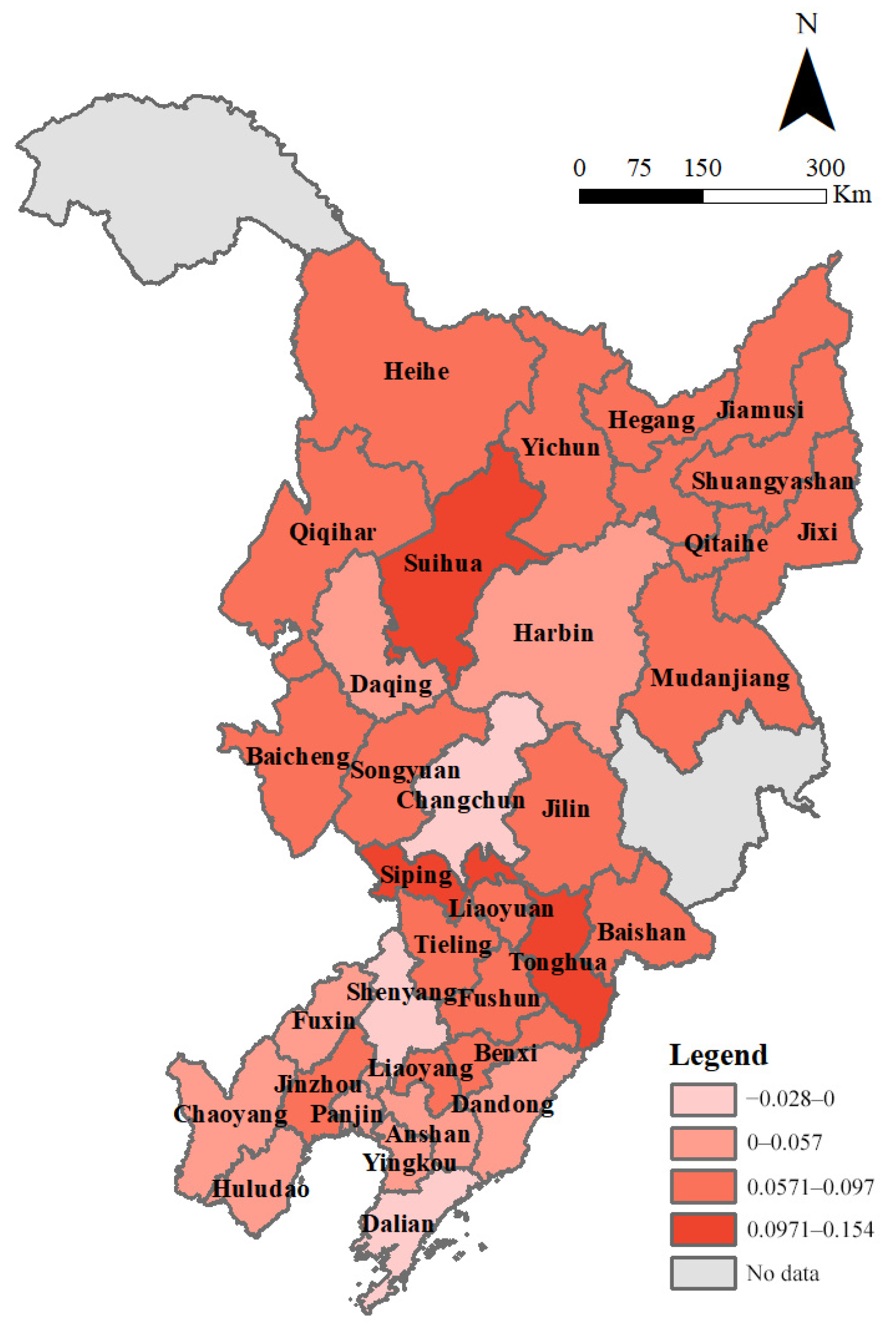
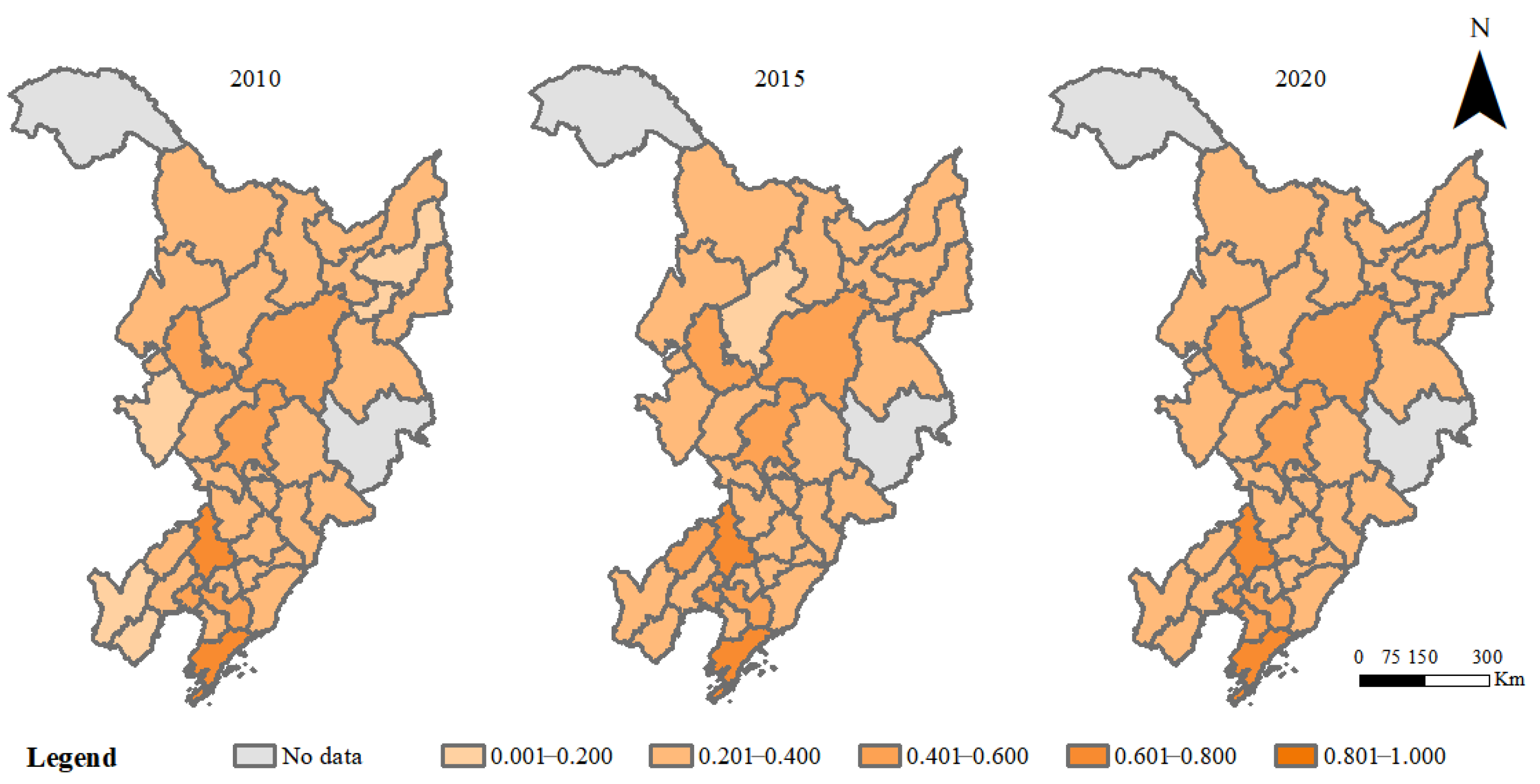
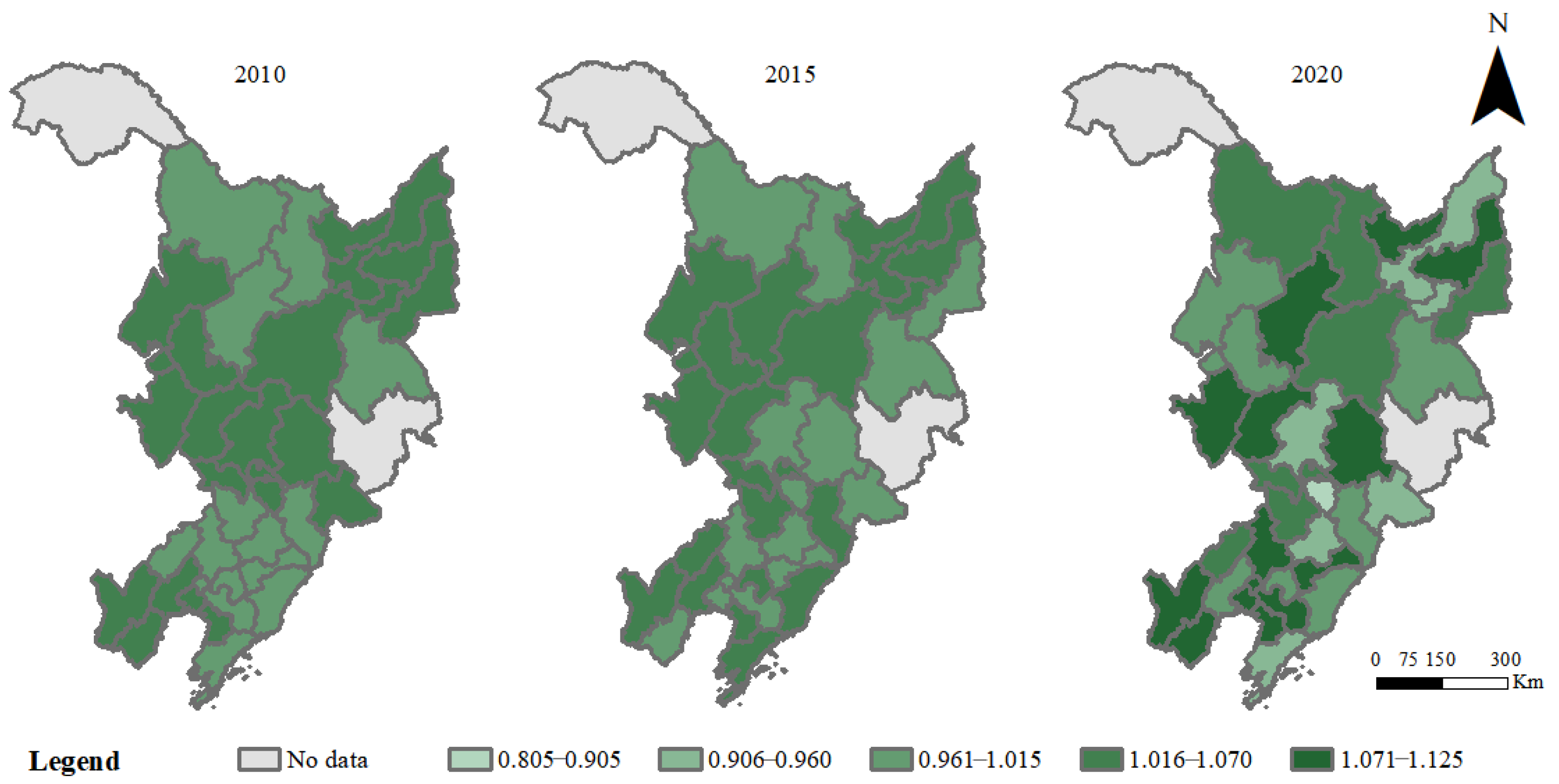
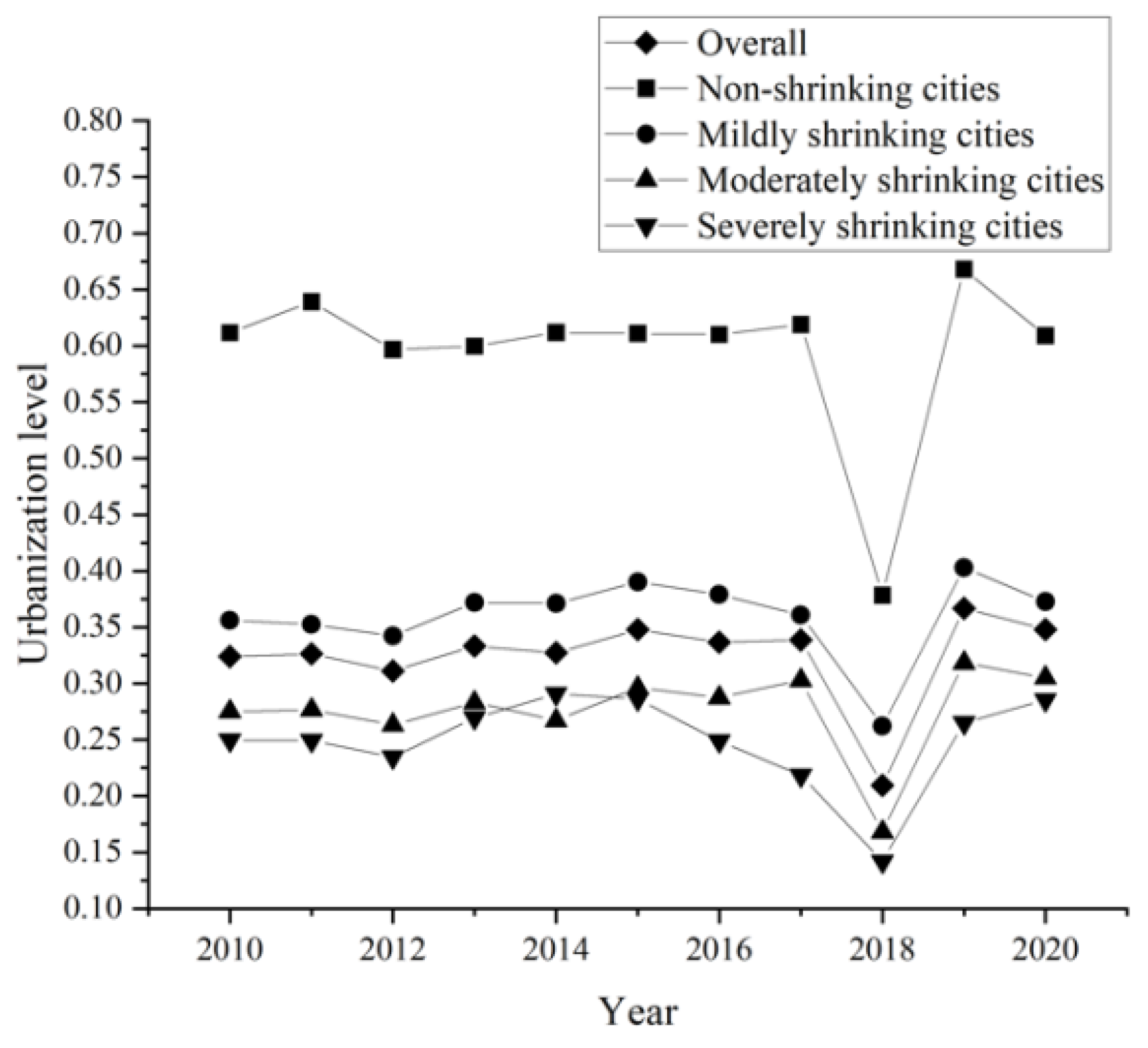

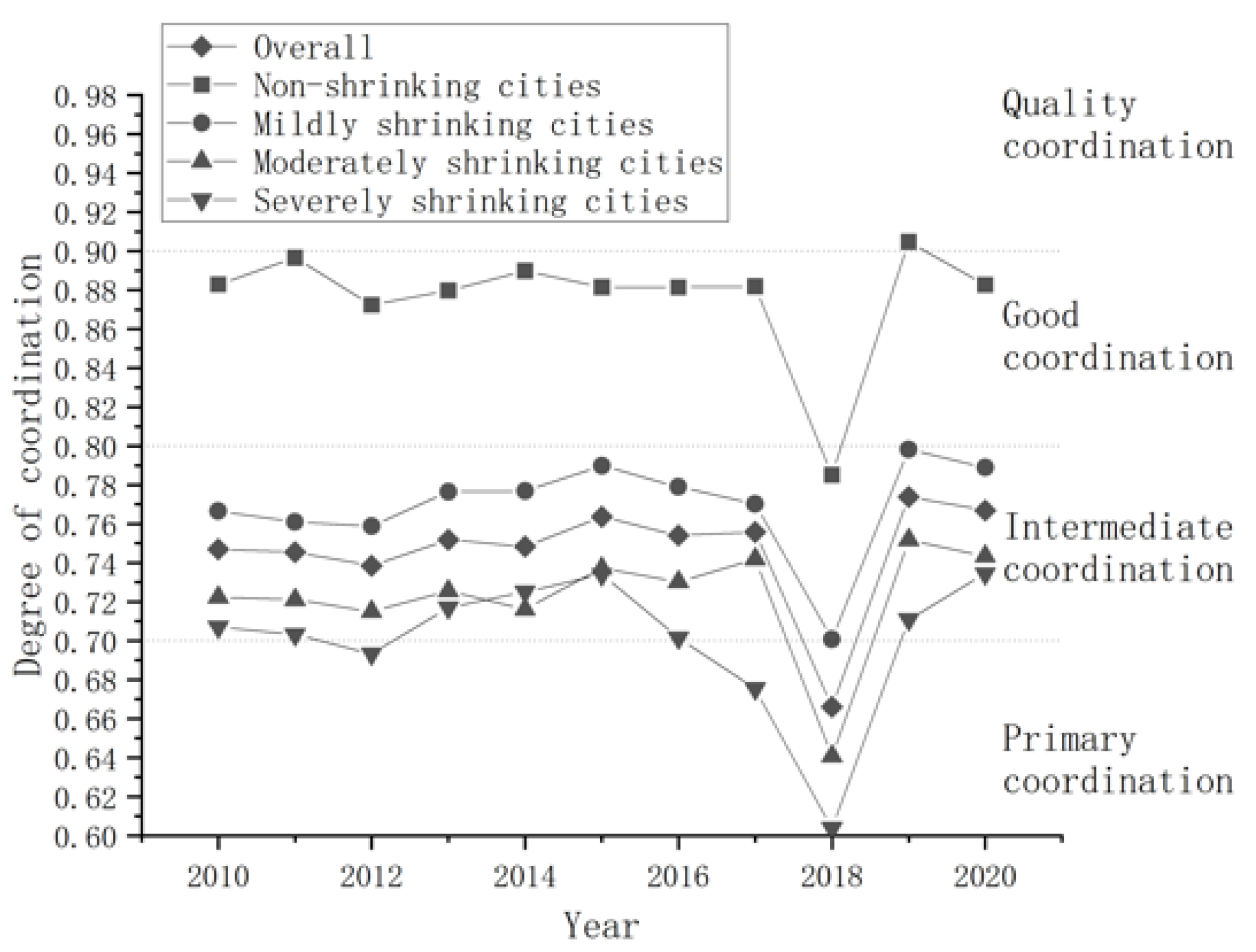

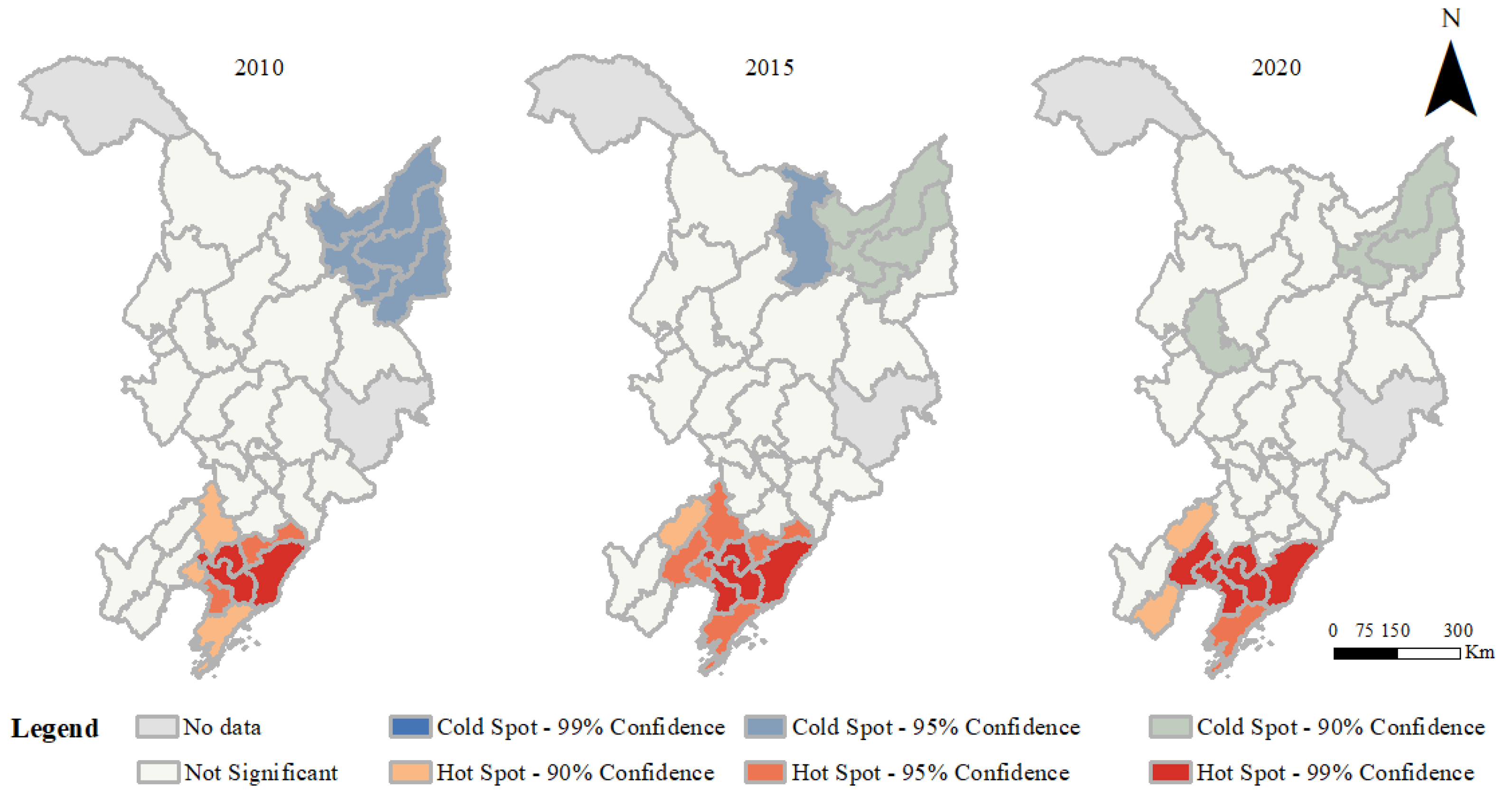
| System | Subsystem | Indicators | Attribute |
|---|---|---|---|
| Shrinkage degree of Northeast China | Degree of demographic change | Total population change | + |
| Tendency of demographic change | Change in the proportion of population aged 0–14 | + | |
| Ageing rate change | − | ||
| Change in natural growth rate | + |
| System | Subsystem | Indicators, Unit | Attribute |
|---|---|---|---|
| Population urbanization | Population agglomeration | Proportion of urban population to total population, % | + |
| Employment structure | Proportion of tertiary industry workers, % | + | |
| Urban registered unemployment rate, % | − | ||
| Educational level | Share of students in higher education, % | + | |
| Economic urbanization | Economic scale | GDP per capita, yuan | + |
| Per capita disposable income of urban residents, yuan | + | ||
| Industry structure | The proportion of tertiary industry in GDP, % | + | |
| Socialurbanization | Medical and cultural level | Number of beds in medical and health institutions, 10,000 people | + |
| Number of health technicians, 10,000 people | + | ||
| Public library collections, 10,000 people | + | ||
| Basic guarantee | Medical insurance coverage, % | + | |
| Share of education spending, % | + | ||
| Internet penetration rate, % | + | ||
| Spatialurbanization | Land use | Proportion of construction land, % | + |
| Infrastructure | Urban road area per capita, m2 | + | |
| Number of public transport vehicles, 10,000 people | + | ||
| Ecological urbanization | Ecological restoration | Greening coverage rate of built-up area, % | + |
| Parkland per capita, m2 | + | ||
| Pollution control | Sewage treatment rate, % | + | |
| Harmless disposal rate of domestic waste, % | + |
| System | Subsystem | Indicators, Unit | Attribute |
|---|---|---|---|
| Inputs | Capital investment | Capital stock of fixed assets, billion yuan | + |
| Labor input | Number of employees, millions | + | |
| Energy input | Energy consumption, kW·h | + | |
| Outputs | Expected output | Regional GDP, billion yuan | + |
| Non-desired outputs | Industrial wastewater discharge, tons | − | |
| Industrial sulfur dioxide emissions, tons | − | ||
| Industrial dust emissions, tons | − |
| D Range | Coordination Level | D Range | Coordination Level | ||
|---|---|---|---|---|---|
| 1 | 0 ≤ D ≤ 0.1 | Extreme disorder | 6 | 0.5 < D ≤ 0.6 | Barely coordinated |
| 2 | 0.1 < D ≤ 0.2 | Severe disorder | 7 | 0.6 < D ≤ 0.7 | Primary coordination |
| 3 | 0.2 < D ≤ 0.3 | Moderate disorder | 8 | 0.7 < D ≤ 0.8 | Intermediate coordination |
| 4 | 0.3 < D ≤ 0.4 | Mild disorder | 9 | 0.8 < D ≤ 0.9 | Good coordination |
| 5 | 0.4 < D ≤ 0.5 | On the verge of disorder | 10 | 0.9 < D ≤ 1.0 | Quality coordination |
| Type | Cities | Corresponding Total Population Change Rate Range |
|---|---|---|
| Non-shrinking cities (−0.028–0) | Changchun, Shenyang, Dalian | >0 |
| Mildly shrinking cities (0–0.057) | Panjin, Yingkou, Daqing, Chaoyang, HarbinHuludao, Anshan, Fuxin, Dandong | −10%~0 |
| Moderately shrinking cities(0.0571–0.097) | Hegang, Tieling, Jinzhou, Liaoyang, Jiamusi, Liaoyuan, Shuangyashan, Mudanjiang, Jixi, Jilin, Fushun, Yichun, Songyuan, Benxi, Heihe, Baicheng, Qiqihar, Baishan, Qitaihe | −30%~−10% |
| Severely shrinking cities(0.0971–0.154) | Suihua, Tonghua, Siping | <−30% |
| Cities | 2010 | 2020 | Average | |||
|---|---|---|---|---|---|---|
| Urbanization | GTFP | Urbanization | GTFP | Urbanization | GTFP | |
| Overall | 0.3239 | 1.0159 | 0.3481 | 1.0290 | 0.3245 | 1.0110 |
| Non-shrinking cities | 0.6116 | 1.0014 | 0.6090 | 1.0051 | 0.5959 | 1.0047 |
| Mildly shrinking cities | 0.3561 | 1.0235 | 0.3728 | 1.0616 | 0.3602 | 1.0148 |
| Moderately shrinking cities | 0.2749 | 1.0159 | 0.3051 | 1.0167 | 0.2766 | 1.0111 |
| Severely shrinking cities | 0.2498 | 1.0075 | 0.2852 | 1.0329 | 0.2491 | 1.0048 |
| Cities | 2010 | 2020 | ||
|---|---|---|---|---|
| D | Coordination Level | D | Coordination Level | |
| Overall | 0.7469 | Intermediate coordination | 0.7669 | Intermediate coordination |
| Non-shrinking cities | 0.8829 | Good coordination | 0.8827 | Good coordination |
| Mildly shrinking cities | 0.7665 | Intermediate coordination | 0.7888 | Intermediate coordination |
| Moderately shrinking cities | 0.7224 | Intermediate coordination | 0.7434 | Intermediate coordination |
| Severely shrinking cities | 0.7071 | Intermediate coordination | 0.7345 | Intermediate coordination |
| Year | Moran’s I | p-Value | Z-Value |
|---|---|---|---|
| 2010 | 0.051 | 0.009 | 2.618 |
| 2011 | 0.033 | 0.038 | 2.071 |
| 2012 | 0.034 | 0.037 | 2.085 |
| 2013 | 0.097 | 0.000 | 4.096 |
| 2014 | 0.100 | 0.000 | 4.196 |
| 2015 | 0.070 | 0.001 | 3.237 |
| 2016 | 0.080 | 0.000 | 3.595 |
| 2017 | 0.017 | 0.118 | 1.561 |
| 2018 | 0.065 | 0.001 | 3.215 |
| 2019 | 0.037 | 0.029 | 2.183 |
| 2020 | 0.051 | 0.008 | 2.644 |
| Category | Variable Name | Variable Symbols | Variable Description | Unit |
|---|---|---|---|---|
| Explained variables | Coupling coordination | D | Calculation results of the coupling coordination model | / |
| Explanatory variables | Level of government intervention | gov | Total government spending as a percentage of GDP | % |
| Industry structure | ind | Ratio of secondary industry to tertiary industry | % | |
| Level of external opening | open | Foreign direct investment as a proportion of GDP | % | |
| Technology input | tec | Science and technology spending as a share of GDP | % | |
| Knowledge spillover | kno | Share of education technology employees | % | |
| Environmental regulation | er | Environmental Word Frequency Composite Index | % |
| Influencing Factors | CCD of Urbanization and GTFP | |||||
|---|---|---|---|---|---|---|
| Spatial Economic Distance Matrix | Spatial Geographic Distance Matrix | |||||
| Double Fixed | Fixed Time | Individual Fixation | Double Fixed | Fixed Time | Individual Fixation | |
| gov | −0.00593 (−1.36) | −0.0349 *** (−4.16) | −0.00371 (−0.77) | −0.00369 (−0.83) | −0.0605 *** (−6.41) | −0.00520 (−1.13) |
| ind | 0.0106 ** (3.24) | 0.00879 * (2.03) | 0.00534 (1.57) | 0.0140 *** (3.96) | 0.0158 ** (2.70) | 0.00857 ** (2.59) |
| open | 0.00446 (0.15) | 0.144 * (2.35) | −0.000652 (−0.02) | −0.00203 (−0.07) | 0.237 *** (3.41) | 0.00727 (0.23) |
| tec | 0.362 (0.47) | 5.864 *** (4.56) | −0.463 (−0.55) | 0.151 (0.19) | 6.988 *** (4.35) | 0.128 (0.16) |
| kno | 0.0630 (0.76) | −0.310 *** (−4.71) | 0.0336 (0.37) | 0.102 (1.24) | −0.605 *** (−7.38) | 0.0839 (0.97) |
| er | 1.229 (1.18) | −3.885 * (−2.24) | 1.967 (1.74) | 2.264 * (2.03) | −8.474 *** (−3.95) | 1.854 (1.69) |
| WX | Yes | Yes | Yes | Yes | Yes | No |
| Coefficient | −0.165 (−1.62) | 0.442 *** (5.82) | 0.719 *** (19.47) | −0.285 (−1.31) | 0.110 (0.61) | 0.840 *** (25.12) |
| R2 | 0.0454 | 0.0467 | 0.0231 | 0.00397 | 0.0480 | 0.0231 |
| Sigma2 | 0.000417 *** (13.65) | 0.00192 *** (13.33) | 0.000520 *** (13.41) | 0.000427 *** (13.65) | 0.00263 *** (13.65) | 0.000474 *** (13.51) |
| Log-L | 923.9074 | 635.7808 | 863.4688 | 919.7746 | 580.5328 | 887.2716 |
| Influencing Factors | CCD of Urbanization and GTFP | |||||
|---|---|---|---|---|---|---|
| Spatial Economic Distance Matrix | Spatial Geographic Distance Matrix | |||||
| Direct Effect | Indirect Effect | Total Effect | Direct Effect | Indirect Effect | Total Effect | |
| gov | −0.0389 *** (−4.38) | −0.0891 (−1.93) | −0.128 ** (−2.59) | −0.0606 *** (−6.20) | −0.0909 (−0.91) | −0.152 (−1.48) |
| ind | 0.0212 *** (3.96) | 0.258 *** (5.44) | 0.279 *** (5.47) | 0.0165 ** (2.79) | 0.164 * (2.57) | 0.180 ** (2.70) |
| open | 0.197 ** (2.92) | 0.968 * (2.25) | 1.165 * (2.47) | 0.253 *** (3.72) | 1.734 * (2.39) | 1.987 ** (2.70) |
| tec | 6.467 *** (4.74) | 13.85 * (2.08) | 20.32 ** (2.76) | 6.843 *** (4.26) | −12.70 (−0.81) | −5.856 (−0.36) |
| kno | −0.349 *** (−5.38) | −0.805 * (−2.53) | −1.154 *** (−3.43) | −0.598 *** (−7.23) | 1.528 * (2.17) | 0.930 (1.29) |
| er | −4.471 * (−2.51) | −13.02 (−1.39) | −17.49 (−1.73) | −8.630 *** (−4.01) | −34.63 (−1.42) | −43.26 (−1.71) |
| CCD of Urbanization and GTFP | ||||
|---|---|---|---|---|
| Non-Shrinking Cities | Mildly Shrinking Cities | Moderately Shrinking Cities | Severely Shrinking Cities | |
| gov | −0.094 (0.229) | 0.050 ** (0.017) | −0.005 (0.004) | −0.115 *** (0.010) |
| ind | −0.036 (0.020) | 0.016 *** (0.004) | −0.000 (0.011) | −0.129 ** (0.026) |
| open | −0.039 (0.028) | 0.018 (0.178) | 0.004 (0.028) | 0.561 *** (0.018) |
| tec | 3.221 (3.045) | −8.920 ** (3.236) | 0.567 (1.214) | −3.343 *** (0.118) |
| kno | 0.008 (0.163) | −0.057 (0.176) | 0.218 (0.170) | −0.863 (0.613) |
| er | −5.180 (2.328) | −1.243 (2.350) | 2.521 (1.863) | 0.100 (6.068) |
| _cons | 0.949 *** (0.050) | 0.749 *** (0.023) | 0.694 *** (0.012) | 1.032 *** (0.148) |
| N | 33.000 | 99.000 | 209.000 | 33.000 |
| R2 | 0.933 | 0.612 | 0.691 | 0.861 |
Disclaimer/Publisher’s Note: The statements, opinions and data contained in all publications are solely those of the individual author(s) and contributor(s) and not of MDPI and/or the editor(s). MDPI and/or the editor(s) disclaim responsibility for any injury to people or property resulting from any ideas, methods, instructions or products referred to in the content. |
© 2024 by the authors. Licensee MDPI, Basel, Switzerland. This article is an open access article distributed under the terms and conditions of the Creative Commons Attribution (CC BY) license (https://creativecommons.org/licenses/by/4.0/).
Share and Cite
Wang, X.; Wu, X.; Chu, N.; Zhang, Y.; Wang, L. Coupling Relationship between Urbanization and Green Total Factor Productivity in the Context of Population Shrinkage: Evidence from the Rust Belt Region of China. Sustainability 2024, 16, 1312. https://doi.org/10.3390/su16031312
Wang X, Wu X, Chu N, Zhang Y, Wang L. Coupling Relationship between Urbanization and Green Total Factor Productivity in the Context of Population Shrinkage: Evidence from the Rust Belt Region of China. Sustainability. 2024; 16(3):1312. https://doi.org/10.3390/su16031312
Chicago/Turabian StyleWang, Xi, Xiangli Wu, Nanchen Chu, Yilin Zhang, and Limin Wang. 2024. "Coupling Relationship between Urbanization and Green Total Factor Productivity in the Context of Population Shrinkage: Evidence from the Rust Belt Region of China" Sustainability 16, no. 3: 1312. https://doi.org/10.3390/su16031312
APA StyleWang, X., Wu, X., Chu, N., Zhang, Y., & Wang, L. (2024). Coupling Relationship between Urbanization and Green Total Factor Productivity in the Context of Population Shrinkage: Evidence from the Rust Belt Region of China. Sustainability, 16(3), 1312. https://doi.org/10.3390/su16031312






